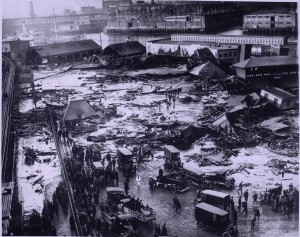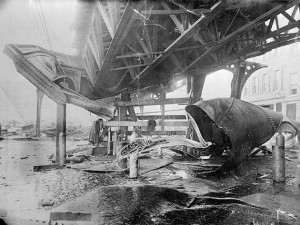Boston Molasses Disaster
The Boston Molasses Disaster or Boston Molasses Flood is one of the more bizarre disasters in American history. On January 15, 1919 a huge molasses tank failed explosively, sending a flood of hot, sticky, sweet molasses through the streets of Boston’s North End.
As you might expect, over a hundred lawsuits were brought in the months and years following the disaster. Over 3,000 witnesses testified in court, and 45,000 pages of testimony and arguments were generated. The Purity company tried to blame the tank’s failure on an outside explosion, a bomb planted by an anarchist (the disaster occurred right after World War I, when the “anarchy scare” was at its height). The supposed motive was because the molasses was destined to be made into industrial ethyl-alcohol, which was used in the munitions industry. The prosecution argued that the tank was not reinforced properly and was not properly inspected. Other factors could have come into play, such as the fact that the temperature went from 2°F the prior day to an unseasonably warm 41°F the day of the explosion, and internal pressure could have built up in fermentation or other processes. In addition, the tank had only been filled to capacity eight times, putting a cyclical load on the structure. After 6 years, the trials eventually found no evidence for a bomb and laid the blame on the Purity company. Around a million dollars was paid out to claimants (about 12 million today).
A number of urban legends have persisted in the years following the disaster, such as the one which states that on a hot summer day, one can still smell molasses in the North End. Another legend purports the tank was overfilled in expectation of Prohibition (since molasses is also used to distill into rum). Time has distanced us from the tragic nature of the incident and allows us to appreciate the local’s name for it: “The Boston Molassacre”.
Sources:
[1] What caused the great Boston Molasses Flood?, The Massachusetts Historical Society
[2] The Molasses Disaster of January 15, 1919, Yankee Magazine
[3] Jan. 15, 1919: Morass of Molasses Mucks Up Boston, Wired Magazine
[4] Boston Molasses Disaster, Wikipedia


How incredible that I have never heard this story as many times as I have been to Boston. Though come to think of it the streets in the North End do seem a little sticky when it’s hot. Great story!